Experts Discuss SOC for Transplant-Eligible Newly Diagnosed Multiple Myeloma
Current standard of care options in transplant-eligible, newly diagnosed multiple myeloma have been outlined in groundbreaking trials, of which a group of experts convened to discuss the best treatment options.
Melissa Alsina, MD Moffitt Cancer Center Tampa, Florida
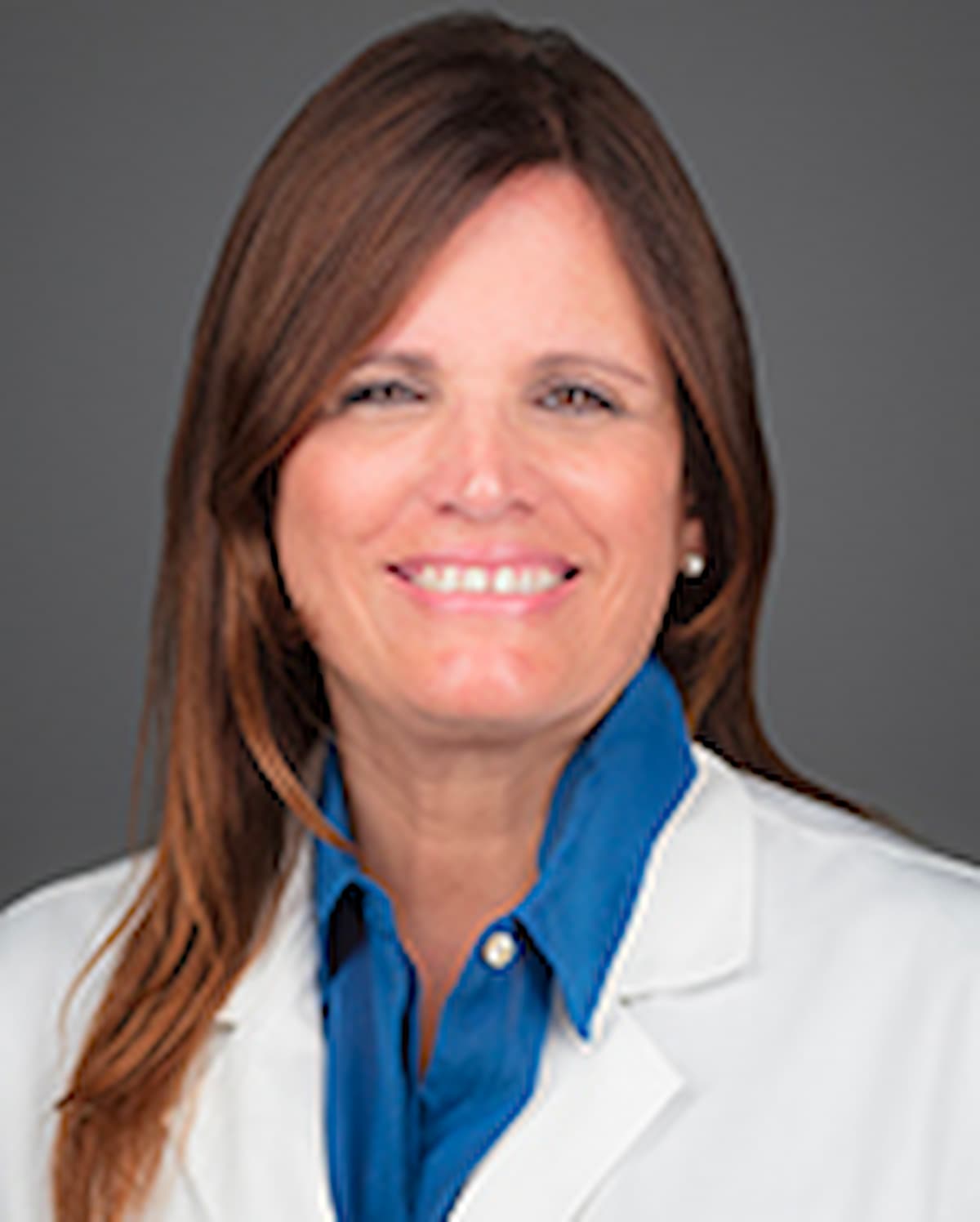
Brandon Blue, MD Moffitt Cancer Center Tampa, Florida
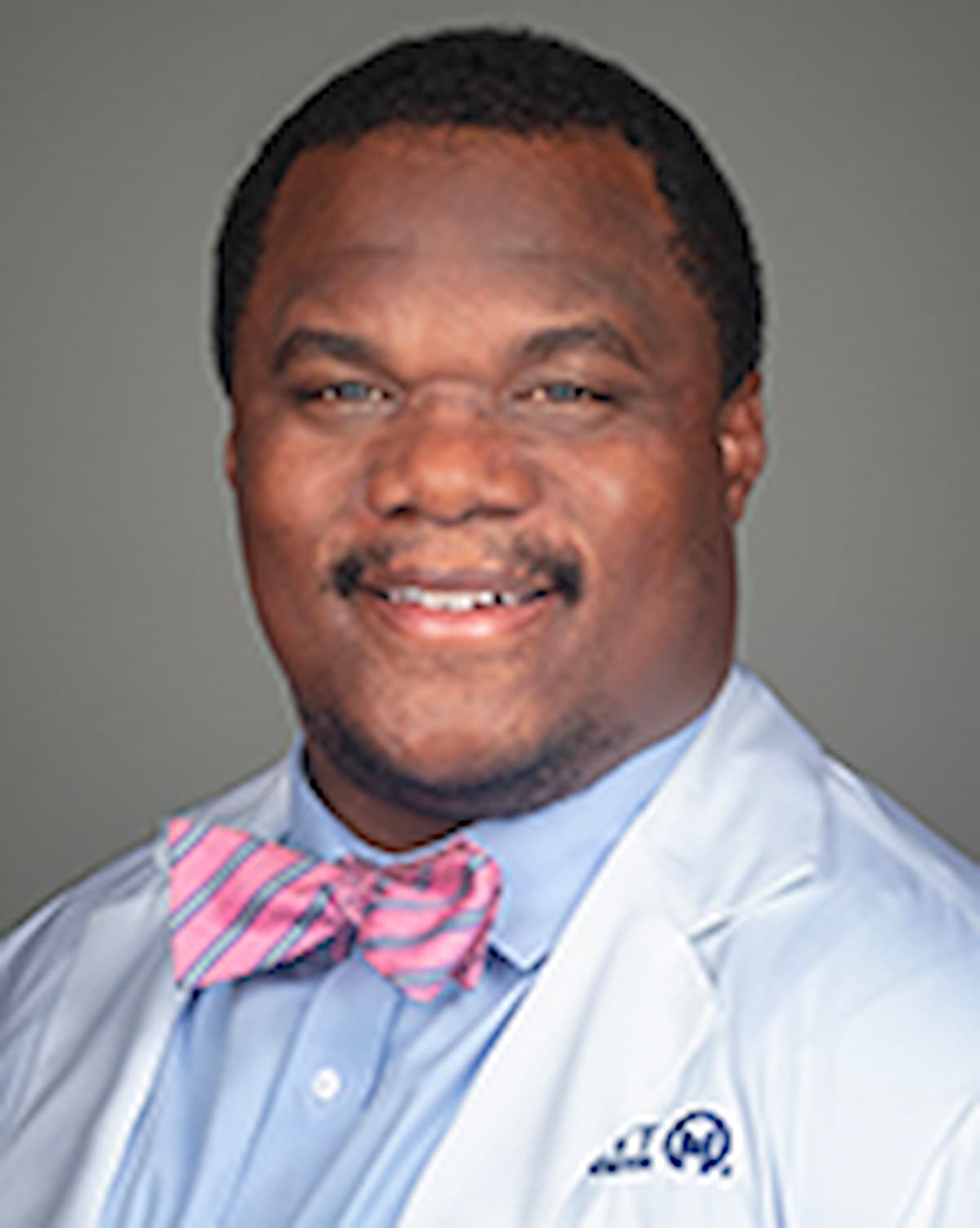
Rachid Baz, MD Moffitt Cancer Center Tampa, Florida
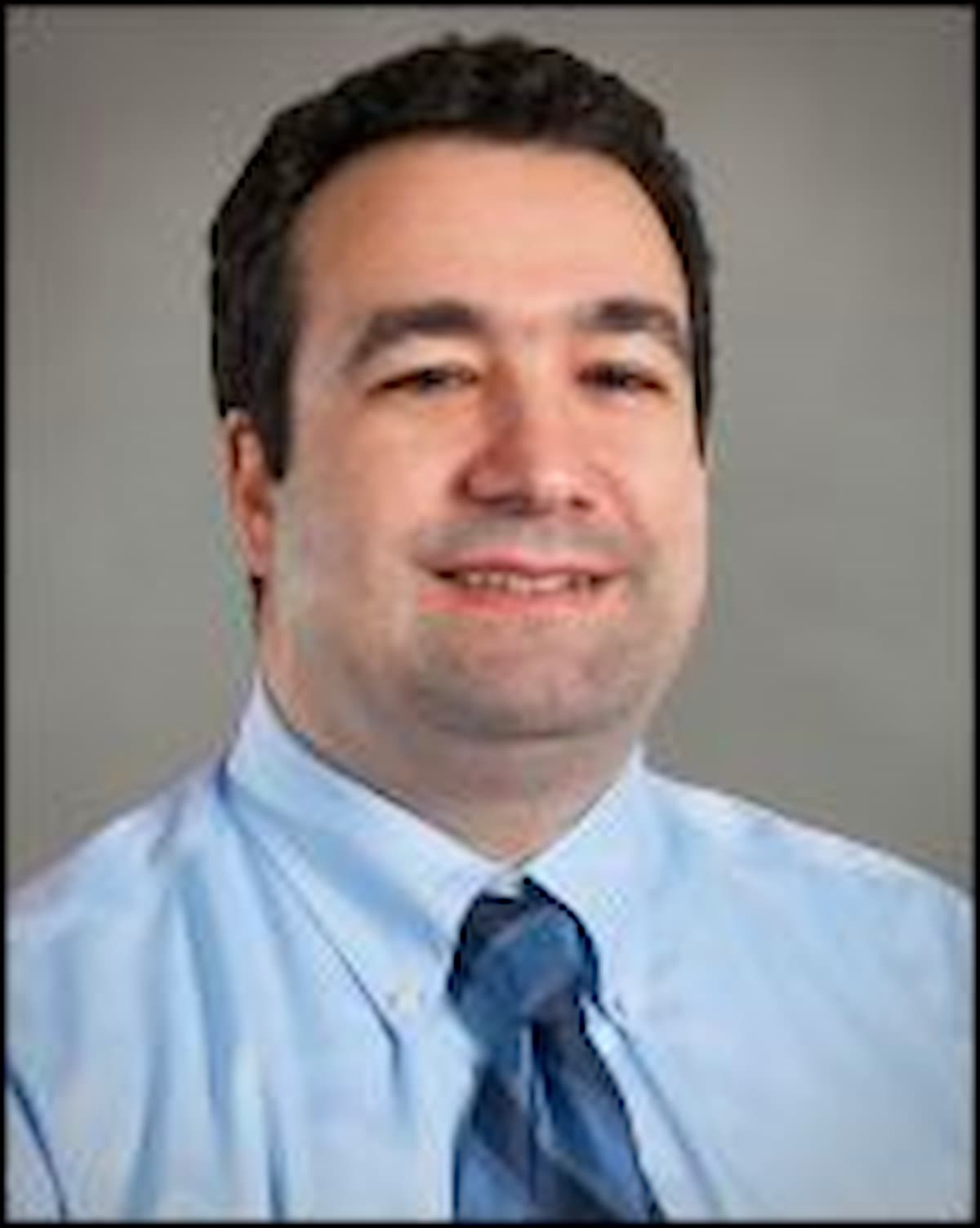
Ken Shain, MD, PhD Moffitt Cancer Center Tampa, Florida

In a recent discussion centered around multiple myeloma, CancerNetwork® called upon a panel of experts from the Moffitt Cancer Center in Tampa, Florida to speak to current treatment options for patients with transplant-eligible, newly diagnosed disease. Highlights from the conversation included how study results from the phase 3 DETERMINATION trial (NCT01208662) have influenced the standard of care for patients with transplant-eligible newly diagnosed multiple myeloma.
The panel was moderated by Melissa Alsina, MD, an associate professor of medicine in the Blood and Marrow Transplant Program and head of the Multiple Myeloma Transplant Program at Moffit Cancer Center.
She was accompanied by her colleagues, Brandon Blue, MD, a medical oncologist; Rachid Baz, MD, Myeloma Section Head in the Department of Malignant Hematology and director of Clinical Research in the Malignant Hematology Department; and Ken Shain, MD, PhD, an associate member in the Malignant Hematology program in the Department of Malignant Hematology, Tumor Biology, and the Chemical Biology and Molecular Medicine Program, an assistant professor at the University of South Florida Morsani College of Medicine in the Department of Oncologic Sciences, and director of the Myeloma Research Center at Moffitt.
Alsina: The DETERMINATION study showed better progression-free survival (PFS) than the phase 3 IFM study (NCT01191060).1,2 How do these data help us treat patients post-transplant?
Shain: These are 2 different studies—2 different patient populations. While they’re chosen for the same purpose by the same criteria, they are still 2 different studies. We have to be a little bit careful in making true comparisons, but the reality is they were designed to be done for the same patient population.
The biggest difference was that it was finite—i.e. time-limited—maintenance therapy in the IFM for 12 months post-transplant, whereas DETERMINATION was a more western, North American–based study. [This included] maintenance therapy, so there was no stopping.
When you mentioned there was a slight improvement in PFS, what was remarkable was that both arms were better. In fact, the control arm for DETERMINATION was essentially the same as the maintenance arm. In IFM, [PFS occurred at] almost 46 or 47 months, and then you added another 20-plus months with transplant in the transplant arm.
This highlights at least 1 hypothesis we can make, which is that continued maintenance, makes a huge difference in outcomes. That’s something we’ve pressed continually. We haven’t done time-limited maintenance therapy, and for those who can tolerate it again on a patient-to-patient basis, it may not be continued forever.
The fact that even the non-transplant arm in the DETERMINATION study was as good at least, this had the same PFS, plus or minus a few months as the transplant arm did in IFM.
Alsina: What is your induction therapy of choice for patients with newly diagnosed multiple myeloma?
Shain: When a patient walks into my office or my clinic and is newly diagnosed, transplant eligible—transplant-eligible to me being anybody less than 75 [years]—I am already thinking about if they’re fit, etc. I’ve fully integrated monoclonal antibodies daratumumab [Darzalex] into my up-front therapy with lenalidomide [Revlimid], bortezomib [Velcade], and dexamethasone [RVd] as an induction to be followed by transplant, and then then the consolidation vs straight to maintenance and risk-adapted in my case.
That’s how I look at an individual who walks into my clinic. Again, MRD [minimal residual disease] negativity before transplant is an intriguing thing for us to make decisions on. I would say that I don’t make that a rule. It’s going to help patients make decisions if they don’t want to do that.
I want to think about that 3-step process of induction, transplant, and then risk adaptive maintenance therapy. I think about sometimes [adding] a little bit of consolidation depending on the response.
Alsina: How would you describe the role of transplant in newly diagnosed multiple myeloma?
Blue: Maybe we can treat patients on an individual basis and not treat all patients the same. We can look sometimes at the response that the patients get from the up-front treatment, but sometimes we determine the next best step. There’s still more information to [determine] exactly which patients should or should not be transplanted.
I think, number one, a referral should take place because the referral is just for us to determine if this patient meets some of those qualifications. Then proceeding with the transplant, is sometimes still yet to be determined. There still may be more information to be [examined] if someone does obtain MRD negativity. Then you ask what benefit may this patient get from the transplant. I think those are some questions that are still yet to be answered.
Right now, the role of transplant is still there and we still see from some of the data that was presented that we do see that PFS benefit is still there. However, it may [not] be for all patients; that’s where more information and more data come out. Who are those patients who can sometimes maybe forgo transplant and still obtain the same level or even better PFS?
Baz: I would completely agree, as I think transplant is still the standard of care for patients who are eligible. We should be careful not to read too much into the subgroup analysis of the DETERMINATION study because, for example, there were fewer benefits seen among African American patients. There was also less benefit seen in ISS [International Staging System] three-stage, but still, a very good benefit seen in high-risk patients who were cytogenetically defined.
How do we put it all together? Is there a way that we can explain that biologically? At this point, we don’t have all the answers. It’s a subset analysis. I don't think that changes the discussion for all those patients.
Blue: Can you give me more context in terms of the patient’s bone marrow results? (Patient Case)
Patient Case
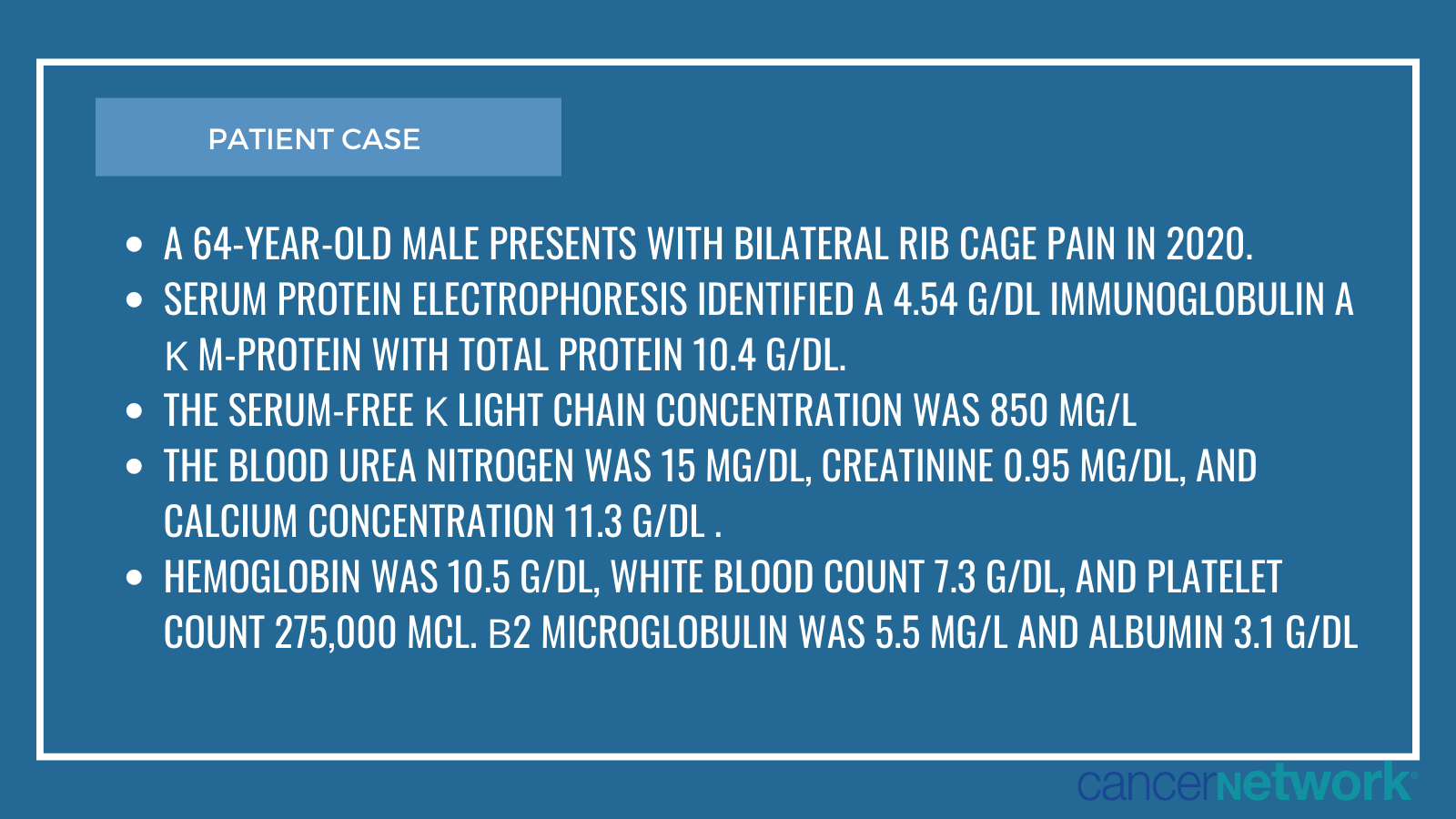
Patient Case cont.
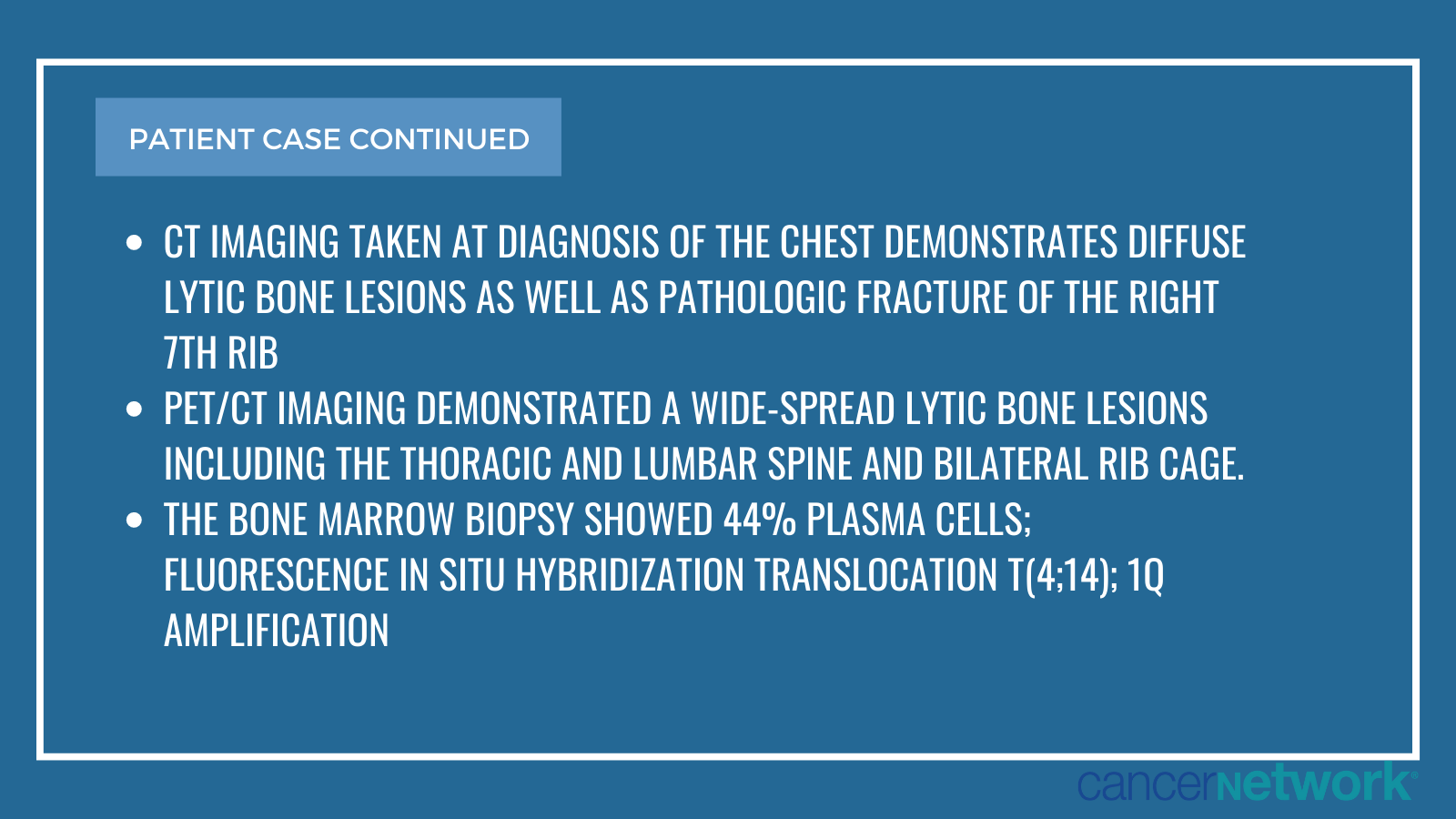
Shain: [These are relatively new results.] Last night I just got an email [about a patient] with about 44% plasma cells in the haploid chain restricted and a translocation at t(4;14) amlodipine 21.
Blue: For the induction regimen with this patient, I would try to lean towards drugs because in this case, this patient is very symptomatic due to those widespread lytic lesions, and you want to make sure that you have rapid disease control. Not only that, but you also want to make sure that this patient is considered to be a potential candidate for a stem cell transplant.
However, after transplant, we have some options. We can say, ‘Well, we see that the natural biology of their disease may be one where traditional lenalidomide maintenance may not suffice.’ Or maybe they give you the type of PFS that you would have hoped. You have options, to do what they consider a doublet maintenance [regimen] by adding on an extra proteasome inhibitor to the lenalidomide.
I would say for this patient up front, I want to get the disease under control—to go from symptomatic to asymptomatic and maybe even include some radiation therapy. I would try to make sure that this patient gets a longer PFS by considering them for autologous stem cell transplant.
Baz: What we don’t know the patient's past medical history—whether they have neuropathy, cardiovascular disease, or diabetes. These are all possibilities that may change my recommendations a little bit, but I generally agree with the drug induction regimen.
Maybe I would try to hold off radiation unless we have the record compression or something that has compelled me to do it with our regimens that have a very high response rate of over 90%. Systemic therapy is also likely to palliate the patients very quickly. A little more information on trying to determine the comorbidities to personalize the decision makes a lot of sense.
Shain: What about the risk adaptive maintenance therapy consolidation?
Alsina: I would use the carfilzomib (Kyprolis) depending on what [we had previously discussed]. I will take this patient to transplant after I get them at least a very good partial response with induction therapy. Then at maintenance, I will use a doublet. Normally we would try to use a proteasome inhibitor along with lenalidomide and I will keep that proteasome inhibitor for 2 years, at least.
If it can be pushed that long, always consider the patient's toxicity and what kind of response the patient has. Obviously, that is in the absence of a clinical trial. The clinical trials evaluating all the other drugs for maintenance, like daratumumab in combination with lenalidomide, could potentially be a good option.
Alsina: What are some future perspectives for newly diagnosed multiple myeloma?
Baz: There are a lot of unmet needs for our patients with myeloma. To me, what’s most important is that we need to generate data that basically look at patients who have not traditionally been enrolled in trials. We need to be able to enroll patients who have traditionally been excluded from studies.
I would love to see patients who have renal failure being permitted in some studies. Allowing it is safe for patients who have had this history of prostate cancer 2 years ago and they’re doing okay. But somehow, they’re arbitrarily excluded from studies. This is the most important thing we can change today: Being able to have patients go on study so that the field can move faster and we can learn more, so we don’t end up with studies that we cannot generalize to the patients we see in the clinics.
This is something that is close to my heart. I think we do need to do better on this end.
Shain: I can’t agree more that we don’t study all the people we need to treat. Studies are done to get therapies and drugs approved, not to see whether we should be treating patients with these drugs or not. We have to balance those things. I’m not going to steal that point because you said it very eloquently.
When I drill down to what I think the need is [in myeloma]—even with these novel therapies, transplant response, and risk adaptive therapies—we still see these marker difference. We’re moving the needle forward, meaning PFS is better for everybody, but it’s disproportionate for the standard-risk patients. These high-risk patients are the folks who we need to figure out care for because they still have half the PFS on whatever study you look at.
We’re doing a lot better when you have quadruplet and triplet [regimens], but they’re still not there; they’re still not reaching the same time points. They’re still dying much earlier.
Our definition of high risk is not that adequate today. We have to figure out what that means. The phase 2 MASTER trial [NCT03224507] brought up a great point. It talks about daratumumab plus carfilzomib, lenalidomide, and dexamethasone inductions to reach MRD negativity.3
These just highlight the fact that high-risk patients are something we have not addressed very well and hopefully as we translate further deeper levels of response [garnered by] immunotherapies, maybe we can start catching up. We just have to keep that in mind when we’re making our decisions, and how we help these individuals more than how we bring them back up to the standard-risk patients.
Blue: The biggest unmet need that I think probably needs to be addressed as soon as possible is the unfortunate disparities happening in myeloma. Unfortunately, we keep coming up with these new therapies but the disparity gap between Black patients and Hispanics is not closing.
Unfortunately, as we continue to come up with new treatments, I worry about that the gap and disparities involving inferior overall survival and worse outcomes may be widening. We have patients who aren’t even transplanted. We have health care utilization—meaning that there are certain groups of people who are very well taking advantage of transplant.
Transplantation is part of the standard of care. There are groups of people who are eligible for it and could receive it but they’re still not. Now that we have CAR T available, how many people are going to do health care utilization where it’s available to them. They should use it, it’s right there, but they’re still not utilizing it. That same kind of story can just be told repeatedly.
That’s one thing that we can focus on because if we have a group of people who are having inferior outcomes, we have to make sure they’re getting some of the best treatments.
Alsina: I don’t have a lot to say because you guys covered everything perfectly. The last point I want to say and to your point, Ken, is about the need to cure myeloma. If we have a patient with myeloma who dies from that disease, there’s still a lot of work to do. We’ve come a long way, but we still have a lot of work to do. We can’t stop at this point.
References
- Richardson PG, Jacobus SJ, Weller EA, et al. Triplet therapy, transplantation, and maintenance until progression in myeloma. N Engl J Med. 2022;387(2):132-147. doi:10.1056/NEJMoa2204925
- Attal M, Lauwer-Cances V, Hulin C, et al. Lenalidomide, bortezomib, and dexamethasone with transplantation for myeloma. N Engl J Med. 2022;376:1311-1320 doi:10.1056/NEJMoa1611750
- Costa LJ, Chhabra S, Medvedova E, et al. Daratumumab, carfilzomib, lenalidomide, and dexamethasone with minimal residual disease response-adapted therapy in newly diagnosed multiple myeloma. J Clin Oncol. 2022;40(25):2901-2912. doi:10.1200/JCO.21.01935
Newsletter
Stay up to date on recent advances in the multidisciplinary approach to cancer.